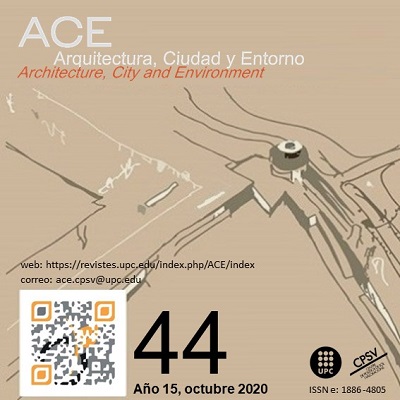Intervention and transformation of natural areas in the context of nano-watershed, as public spaces in the city of Xalapa-Mexico
DOI:
https://doi.org/10.5821/ace.15.44.8984Keywords:
Landscape, urban space, ecological sites, hydrographic basin, watershedsAbstract
The phenomenon of diffuse urbanization and its processes are part of the elements that have caused the transformation of the environment in an accelerated and drastic way. In this urban context, natural areas can remain as traditional public spaces, in other cases; these areas may become residual areas. However, at worst these natural areas may fall into the hands of speculators who compromise their existence, adding them to the urban built environment and constraining their availability. The main interest of this study is to address the forms of intervention and transformation of two natural areas as open public space located on the nano-watershed context of the city of Xalapa, Veracruz. Inscribed in a conceptual framework of planning and design and its interconnection with natural systems, this article examines planning and design decisions for the transformation of natural sites. Methodologically, this analysis is based on the delimitation of the hydrographic system at the sub-basin and micro-basin level where they are located. On hand, the nano-watershed was the basis for the study, due to the importance of water for planning and decision-making when integrating these two areas into the city. On the other hand, design principles were analyzed to integrate a concept of balanced and functional open public space to confront it with the interventions carried out in the case of Xalapa. The results show two forms of appropriation and transformation of the spaces. These two forms emerged from two different ways of interpreting, perceiving, and responding to each of the sites to transform them as public spaces. In addition, the study shows that it is necessary to include and strengthen community interest and participation, as widely as possible, in the decision-making process in the planning of the city and the conservation of natural public spaces.
Downloads
Published
Issue
Section
License
| INTELECTUAL PROTECTION CRITERIA |
At this moment, it is count with the "Oficina Española de Patentes y Marcas", while global protection it is being processed by the World Intelectual Property Organization (OMPI/WIPO). Nevertheless the International Standard Serial Number Office (ISSN) has given the following numbers ISSN: 1886-4805 (electronic version) and 1887-7052 (paper version). All articles will be peer reviewed, using double blind reviewing. |
| COPYRIGHT |
The article contents and their comments are authors exclusive liability, and do not reflect necessarily the journal editor commitee's opinion. All ACE published works are subject to the following licence CC BY-NC-ND 3.0 ES http://creativecommons.org/licenses/by-nc-nd/3.0/es/ It implies that authors do not hold nor retain the copyright without restrictions but only those included in the licence. |





































